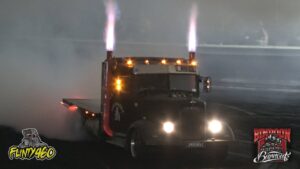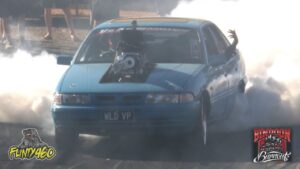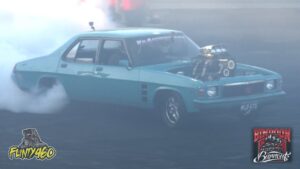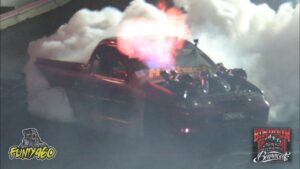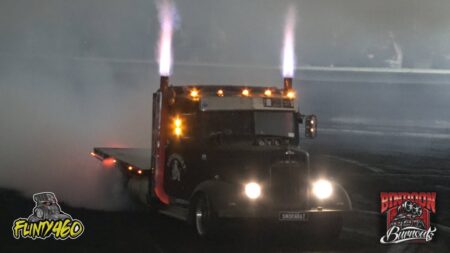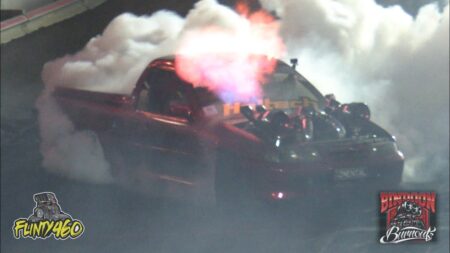It’s Bridget Bell and for your next instalment of Flash Femmes, we have the mother/daughter duo from Skidoo Jet Boat team to give us an overview on the break-neck sport of Jet Boat racing at jetsprintwa.com.au.
I first met these women via Jason Furnell after he came aboard the 26′ Intrinzic I was crewing out of South of Perth Yacht Club. Jason was invited to coach one of our training sessions before the Intrinzic State Championships in 2017.
And that is also how I discovered Jet Boat racing. Jason had explained it to me as “like rally, but on water”.
Mel, let’s start with you. You’ve been exposed to skipper Jason for a long time. Is he as ruthless, strategic and as blood-thirsty with the jet boat as he was on a yacht?
“I’m gonna go with yes, but I’m just as bad. Jason is also my brother, yeah I know” Mel rolls her eyes with good-humoured self deprecation “I guess yachting is different to all aspects of jet boats. You’re in a boat that’s far as the similarities go… I’m navigating and tell Jason where he needs to go.
That’s not the first time you’ve told Jason where to go?
“Now I get to tell him where to go without getting in trouble” Mel chuckles dryly.
“I have to get him around the course… we get given a course a day or two days out which we’ve got to learn. The skippers learn it too, sometimes they don’t learn it so well, so they rely on the Navigator.”
“You’re thinking quicker than on a yacht where you have time to work on your strategy, so you don’t have time to think of where you are going; and I’m telling him where he’s needs be as we’re just coming through one corner. The corners are numbered, if we’re going to corner 7 or corner 6 and we are at 10 he’ll change his approach to the corner to place himself how he wants to exit so we can approach the next.”
“You’ve gotta have an idea of where you want to go and where you’re gonna be. As opposed to the race three weeks ago where he wanted to be around the corner but we decided that it would be more fun to kind of miss the corner and end up out of the water; thankfully without panel damage.”
“During qualifying is our first chance to see how the boat is going to handle the course, in terms of if we need to change anything with the set up, change the blades, address any dramas and then we go ‘All In’ which is all boats in your class. From [the results of] ‘All In’ the top three quickest boats are selected. You want to be in the top three as these will compete in a shoot-out for the placings, also the quickest boat gets to choose if they go first, second or third in the finals. You get to set the pace, or you’re chasing.”
It’s your third season, how long is a season?
“Generally 10 races, we start in November or December depending on what the committee decide and then we go and race every 2 to 3 weeks, but generally a minimum of two weeks… so people have time to fix the boat or repair anything.”
“You may only get between three and ten laps in the boat each time you race, if you’ve got a short course you’ll spend even less time in the boat.”
Correct me if I’m wrong then, if you spend roughly 60 seconds going around the course, and you get 10 laps in on race day, you’ll spend – best case scenario – 100 minutes in the boat in a season? How does that correspond to performance or changing set-up of the boat?
“On a short course it may be even less time than that, more like 30 or 40 seconds, on the long courses it may take a bit longer to go through. It comes down to seeing how you run. Each course has between 20 to 23 corners, just depending on the course; if it’s a bit more winding it is more challenging and it can slow you down a bit more.”
“I’m just thinking in terms of tuning [the boat], obviously you can’t change the balance of the boat fore (toward the bow) or aft (toward the stern) because of the engine mounts and the roll cage. All you can really do is tune your engine, maintenance, change hoses, blades things like that but you don’t get a lot of time during qualifiers.”
“You do have that period of time to react if something happens, because you only need to compete in, and finish, one qualifier before ‘All-In’. You’re trying to run a really consistent season on not very much seat time.”
Most people will be familiar with what an LS motor is, tell me what comes next; you’ve got motor, flywheel; then what?
“You’ve got a gear box, it only has forwards and reverse, a prop shaft. There aren’t any brakes.”
So what do you do? Just Flintstone it and hope for the best?
“You slowly lift off of the throttle and that stops the propulsion and the jet or the turbine stops spinning and that is affectively your brake as it’s dragging in the water. When you’re coming across the finish through turn 11 to the spin-out pool, you come around another bend and as you’re doing that you’re lifting slowly to what we call our ‘Home’. By then you’re only idling back to the Pits.”
“There’s a kill-switch and fire suppression system on board too. It’s funny, because I’m only just learning engines now, I never knew anything about jet boats until Jason bought Skidoo.”
Tell me about race day
“Race practice starts at 2.30pm or 3 o’clock and you’ll just do qualifying so you’ll have boats up on ‘the Land’ waiting to run, it’s a narrow track to go through, it’s only a meter deep and each side of it has tyres on the shoreline. You don’t want to be on the edge.”
“We will run qualifiers until sunset, that’s the point where you can’t see anything for the glare on the water so that’s when we take dinner time. We generally jump back in the boat to do what we call ‘Ride of your Life’.”
“The skippers will take out passengers who have purchased a ride, or sponsors, or anyone else as a ‘thank you’ for a hot-lap. Some people love it, some people come back pale and shaken and just say ‘thank you for putting me in the boat’.”
Mel Wilkey signing posters during tea-break; fans are encouraged to meet the teams in the pits.
“We also open the pits up during dinner to spectators and we’ll sign posters, you can get photos of the kids sitting in the boats and have a look at the boats up close. After dinner, we may have a couple more rounds of qualifying, depending on the schedule and that will see us through to the evening. We will do a ‘roll-out’ where the crew will do a lap without helmets so the crowd can see the driver’s faces.”
As navigator Mel, you and Jason are virtually sitting on top of one another in the boat; like two Sumo wrestlers in a Daihatsu Charade. You have intercoms, do you find them necessary to communicate given your close quarters?
“Some of the boats don’t have intercom and rely on hand signals to navigate. It’s really loud on the boat, on Skidoo we have comms so we can talk to each other… but when I navigate, there’s a little bit of a running joke, once I’m strapped in my arms are too short and Jason can’t see where I’m pointing.”
Mel you’ve been ejected from your position, Olivia; how does it feel ending up in the driver’s seat during this intricate cycle of musical chairs?
“Uncle Jason was helping out with Juniors before he decided to buy Skidoo. He asked if I wanted to have a go in a junior boat and I was like ‘Sure, why not?’ I did 3 years in juniors and now I’m racing Uncle Jason’s boat in the Youth Restricted LS Development class with another boy named Jayden” offered the publicly reserved 15 year old.
How is the LS engine restricted, you’re obviously racing it Olivia, in the same event as Jason?
“I’ve got my own key which changes the settings in the ECU. Jayden’s boat doesn’t have a different key because he’s got his own boat that nobody else races, so I’m not sure how his is restricted.”
“When Professional Rockingham came on board as sponsors we were able to upgrade the ECU, which has also given us diagnostic capabilities. We’ve already identified some minor engine issues, which have probably always been there. But now we know about them and they’re being fixed.”
“You can race legally at 16 years old in the sprint boats and compete with the adults, but I’ll probably do one more season after this of the development class before I move up.”
15 year old Olivia Wilkey stepping up into the new Youth Restricted LS Development class of Jet Sprint Boats in Baldivis.
How do you feel being coached by Jason and what’s it like when he grabs the wheel and makes you crash? We saw the photos, there’s irrefutable evidence.
“He was actually trying to save me from crashing.”
“It’s very different from driving a Junior boat. In a Junior you’re in the middle, but in Skidoo you’re on one side. You have no power in a Junior boat compared to the big boat, it’s not just speed, but the torque is so much greater.”
Jason Furnell corrects steering inputs as Skidoo avoids a near spill.
Olivia, you’ve obviously developed a good deal of discipline through your dancing and football, how do you find that translating to driving the boat?
“The teachers are always really strict, but you have to do what they say because that’s how you get better. It’s the same, I always have to listen to Uncle Jason because it’s his boat and if I break it…” she trails off reluctant to verbalise the ramifications.
“If someone is giving you a hard time to do something, you have to listen. You have to think about what they are telling you. You have to take it on and improve.”
Do you think there’s anything different between you and Jayden competing in the Youth Restricted LS Development class?
I’ve always been a bit different, like I’ve always been the only girl. I don’t find it different because who cares if you’re a dude? I’m a girl and I do the same things, it’s not different. And Jet Boats there are like 5 girls racing and we have different roles too. Like Mum, who navigates for us, another lady drives… there’s no physical barrier, there’s no reason you can’t catch them.”
What are the types of questions you typically get asked about Jet Boat racing?
“People want to know if you crash; I mean your boat can catch on fire, and roll, end up in the water but you’re also really safe in your five point harness, so even if you end up in the water it’s only one clip to release yourself and you’ll be able to get out easy. You have a fire proof suit, a race suit, gloves, shoes, helmet and the ‘Mud-Rats’ are incredible. The ‘Mud-Rats’ is what we call our volunteers that will run out and fetch you back onto the water if you come off.”
“We can’t race without the volunteers, they get in there and help us. It’s not like the sport is without danger, everybody has a role they have to perform and every role is necessary.”
Mel, Olivia; there’s no bad press surrounding Jet Boats, it’s all very wholesome. Everyone pulls their cars up around the track reminiscent of yesteryear grassroots football when you’d pack the family in, cook up a barbie and tune the radio into the commentary, go to the canteen to get a pie…
“Donuts!” Olivia erupts.
“We have a donut man down there and we’ve got coffee” Mel quickly agrees, “you can drive your car in and park around the track. We’re trying to stay really COVID safe, we’ve got the sign-in at the gate and we’re making sure we can still run and that there’s a really bright future for the club.”
Mel and Olivia would like to wholeheartedly thank the Skidoo Jet Boat Team’s sponsors;
Welshpool Auto Electrics
Tune Corp
Scardifields Smash Repairs
Success 5 Engineering
Hudson Car Carriers
Professionals Rockingham
Scene Signs
and Ash





